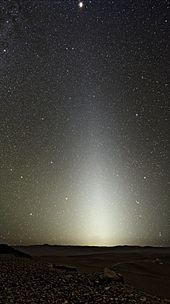Zodiacal light
This article includes a list of references, related reading, or external links, but its sources remain unclear because it lacks inline citations. (January 2010) |

Zodiacal light is a faint, roughly triangular, whitish glow seen in the night sky which appears to extend up from the vicinity of the sun along the ecliptic or zodiac. It is so faint that it is completely masked by either moonlight or light pollution. The zodiacal light decreases in intensity with distance from the Sun, but on very dark nights it has been observed in a band completely around the ecliptic. In fact, the zodiacal light covers the entire sky, being responsible for 60% of the total skylight on a moonless night. There is also a very faint, but still slightly increased, oval glow directly opposite the Sun which is known as the gegenschein.
This phenomenon was first investigated by the astronomer Giovanni Domenico Cassini in 1683 and first explained by Nicolas Fatio de Duillier in 1684.
Viewing

In mid-latitudes, the zodiacal light is best observed in the western sky in the spring after the evening twilight has completely disappeared, or in the eastern sky in the autumn just before the morning twilight appears. The zodiacal light appears as a column, brighter at the horizon, tilted at the angle of the ecliptic. Since the light scattered from extremely small dust particles is strongly forward scattering, although the zodiacal light actually extends all the way around the sky, it's brightest when you're looking in the direction toward the sun, because the scattered light is scattered most strongly in the nearly-forward directions. This is why it is most clearly visible near sunrise or sunset, when the sun is blocked, but the dust particles nearest the line of sight to the sun are not. The dust band that makes up the zodiacal light is actually uniform across the whole ecliptic, but the dust furthest from the ecliptic is almost indetectable, except when viewed looking nearly into the sun. Thus you can see more of the width the closer to the sun you look, and it seems wider near the horizon.
Formation

Zodiacal light is produced by sunlight reflecting off dust particles in the solar system known as cosmic dust. Consequently, its spectrum is the same as the solar spectrum. The material producing the zodiacal light is located in a lens-shaped volume of space centered on the sun and extending well out beyond the orbit of Earth. This material is known as the interplanetary dust cloud. Since most of the material is located near the plane of the solar system, the zodiacal light is seen along the ecliptic. The amount of material needed to produce the observed zodiacal light is amazingly small. If it were in the form of 1 mm particles, each with the same albedo (reflecting power) as Earth's moon, each particle would be 8 km from its neighbors. The gegenschein may be because particles directly opposite the sun as seen from Earth would be in full phase.
The Poynting-Robertson effect causes the particles to spiral slowly into the Sun, thus requiring a continuous source of new particles to maintain the zodiacal cloud. Cometary dust and dust generated by collisions among the asteroids are believed to be mostly responsible for the maintenance of the dust cloud producing the zodiacal light and the gegenschein. In recent years, observations by a variety of spacecraft have shown significant structure in the zodiacal light including dust bands associated with debris from particular asteroid families and several cometary trails.
Historical explanations
Previously, it was believed that zodiacal light was just the atmosphere of the sun. According to the 1728 Cyclopaedia:
- "The zodiacal light is nothing but the solar atmosphere, a rare and subtile fluid, either luminous by itself, or made so by the rays of the sun surrounding its globe; but in a greater quantity, and more extensively, about its equator, than any other."
Importance to Islam
The Islamic prophet Muhammed is known to have described zodiacal light in reference to the timing of the five daily prayers, calling it the "false dawn," (Template:Lang-ar الفجر الكاذب). Muslim oral tradition preserves numerous sayings, or hadith, in which Muhammed describes the difference between the light of false dawn, appearing in the sky long after sunset, and the light of the first band of horizontal light at sunrise, the true dawn. Practitioners of Islam use Muhammed's descriptions of zodiacal light to avoid errors in determining the timing of daily prayers.
Such practical descriptions and applications of astronomical observations were vital to the golden age of Islamic astronomy.
See also
References
- Reach, W. T. (1997). "The structured zodiacal light: IRAS, COBE, and ISO observations". Diffuse Infrared Radiation and the IRTS. ASP Conference Series. 124, 33–40
 This article incorporates text from a publication now in the public domain: Chambers, Ephraim, ed. (1728). Cyclopædia, or an Universal Dictionary of Arts and Sciences (1st ed.). James and John Knapton, et al.
This article incorporates text from a publication now in the public domain: Chambers, Ephraim, ed. (1728). Cyclopædia, or an Universal Dictionary of Arts and Sciences (1st ed.). James and John Knapton, et al. {{cite encyclopedia}}: Missing or empty|title=(help)
External links
- A Brief History of Observations
- "Zodiacal Light and the Gegenschein", an essay by J. E. Littleton
- Zodiacal Light and the False Dawn September 25, 2007
- Zodiacal Light Over Laguna Verde October 29, 2009
- Zodiacal light as seen from above the Himalayan Hills in Uttarakhand, India
- Examples of zodiacal light descriptions in Islamic tradition, and their application

